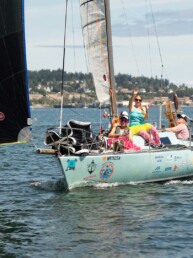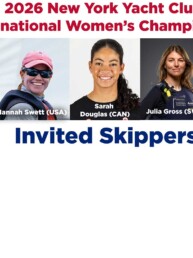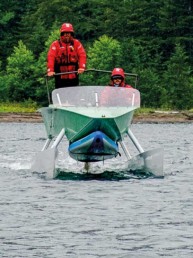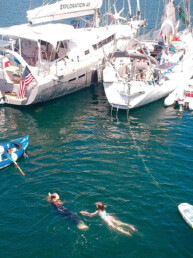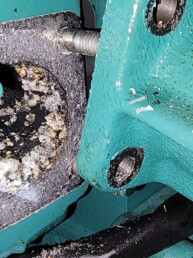The region’s most storied long distance sailboat race gave its participants a wide array of challenges this year—from gear busting wind to zero wind in opposing current.
The 2024 version of the Swiftsure International Yacht Race will go down as a demanding race with challenges coming in different forms, depending on what leg of the race you were on. The three traditional long distance courses typically consist of four distinct legs—start to Race Passage, Race Passage to the turning mark, turning mark back to Race Passage, and Race Passage to the finish line at Ogden Point.
Each leg often requires its own unique strategies, and the race is never over until you reach the finish. You can sail the first three legs perfectly but lose it all in the last leg from Race Passage. And the opposite is also true—it’s a race you never give up on, as the course can deliver great opportunities for those who push hard and make smart tactical decisions on that final leg to the finish.
While the challenges in this year’s Swiftsure impacted everyone, they were particularly hard on the smaller boats with shorter waterline length that were sailing the longer distance courses:
- The first leg challenge was starting in 25 knots of breeze with gusts close to 30 knots and a lumpy sea state caused by the ebb current.
- The second leg challenge was deciding how early to cross to the American shore as the northwest wind in the Strait of Juan de Fuca was forecast to back to the west-southwest in the afternoon.
- The third leg challenge was keeping the boat moving downwind in an easterly direction to stay in the receding and lightening breeze while dodging outbound cruise ships and tankers on a very dark night.
- The fourth leg challenge was likely the most significant. As the wind glassed off approaching Race Rocks, you had to find enough breeze to keep the boat moving to make the current gate at Race Rocks before 0400 Sunday morning and the finish line by 0700 before the current washed you back to Race Rocks.
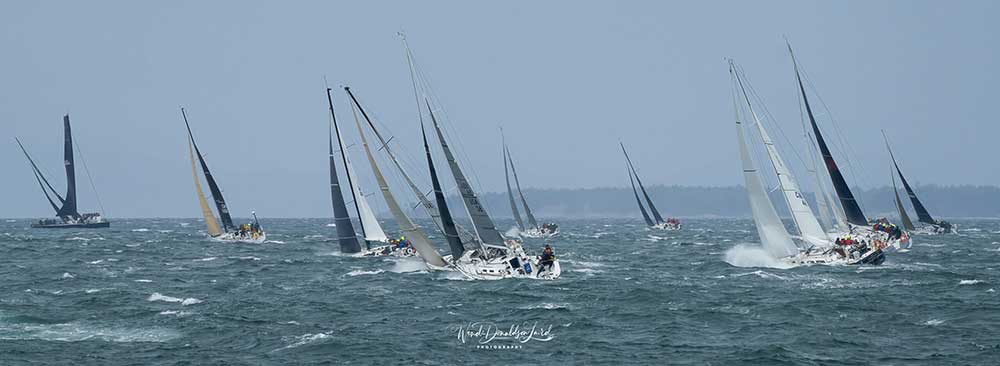
At the start, the seven boats on the Swiftsure Classic fleet got away cleanly, but the very large 64-boat Cape Flattery fleet was over eager on their first start requiring a general recall. On our second attempt, the fleet was better behaved and we got away cleanly. Reefed mains and J4 jibs were fashionable to beyond Race Passage and the first casualties in the large and highly competitive Cape Flattery ORC fleet were experienced in these breezy conditions, with three of the TP52s having to retire with a variety of technical problems and breakages (Glory shortly after the start, and Smoke and The Shadow pre-start).
On my Riptide 35, Longboard, we opted for a double reefed main and J4 jib, got a good pin-end start, and were very happy with our upwind speed despite the nasty sea state as we sailed into the max ebb current stream. We were holding on to the longer 40 to 45 footers fairly well with a few exceptions. Like many fellow race boats, we opted to go outside of Race Rocks and gambled that the west-southwest wind shift would occur early, thus deciding to lead our division over to the American shore. As it turned out, that was a bad call, as there was a nice “rightie” shift that prevailed for a while, which the smart boats took advantage of.
As we closed with the American shore, we did claw back much of that loss on the west-southwest “leftie.” From there to Neah Bay, it was largely a long port tack board along the American shore and a boat speed race climbing over the tall swells coming from the northwest. By the time we got to Clallam Bay, the reefs were out and everyone had switched to their J1 jibs as the breeze lightened into the 10 to 15 knot range.
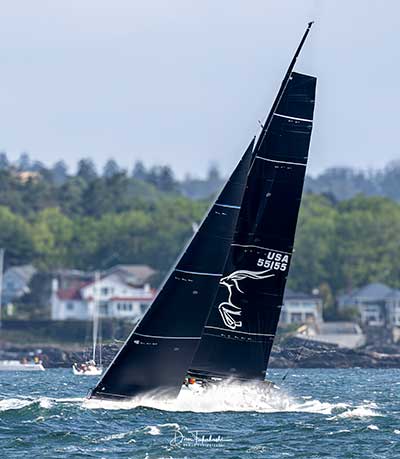
The big boys on the Cape Flattery course (TP52 Mist and Reichel Pugh 55 Zvi) loved the upwind beat, sailed a great leg, and rounded 7.5 hours after the start, with Zvi leading Mist by 11 minutes. But the first boat in the ORC fleet on corrected time was John Murkowski’s J/122e Joy Ride who sailed a masterful leg to Neah Bay and rounded a full 51 minutes ahead of us. We now had our work cut out for us on leg 3 and 4 to reel them back in. Honorable mentions go out to J/111 65 Red Roses, Farr 39CR Tachyon, and Club Swan 42 Free Bowl of Soup who all sailed well and rounded in good shape at the Neah Bay turning mark.
On the Swiftsure Classic long course, Dan Sinclair’s Andrews 77 Mach 2 rounded the bank first, 10.5 hours after the start, which surprised no one. More surprising was Ged McLean’s Wylie 43 Hana Mari, who rounded only 11 minutes after that and was the half course corrected time leader by a substantial margin. Kudos to Ged and team!
In the Juan de Fuca race, the scratch boat was Mark Insley’s Jespersen 42 Zulu who rounded the Clallam Bay mark first but on corrected time was 2 seconds behind Clint Abbott’s Jeanneau SO37 Noflyk and being pushed hard by Chris Ladd’s Grand Surprise 31 Fortissimo, Don Leighton’s J/35 Tahlequah, and John Bailey’s lovely Burns 49 schooner Sir Isaac.
So now for legs 3 and 4—the return trip home and the race to beat the tide gate! The long downwind sail home was pleasant, with 10 to 15 knot winds that held up for Zvi and Mist all the way to the finish, with both boats finishing well before midnight; I’ll guess they made it to the Sticky Wicket Pub for last call! Zvi took line honors but Mist won the division and ORC overall by almost 4 minutes over Zvi. Congratulations go out to Steve Johnson and his team for a well prepared boat that stood up to the demanding conditions on leg 1 and sailed a great race overall.
On Longboard, we returned by working our way to the Canadian shore early, where the models suggested the west-northwest wind would hold up longer as it receded and started to die off. As usual, you had to keep a close eye on AIS when crossing the shipping lanes and, in two cases, we had to jibe away to the north to avoid outbound commercial traffic. Through the night, you also had to keep a vigilant lookout for the slower Juan de Fuca Race boats with no AIS transponders. No one gets any rest on leg 3 to Race Rocks!
We were able to catch up and pass Joy Ride, Free Bowl of Soup, Tachyon and 65 Red Roses by Race Rocks, but it was going to take a strong leg 4 performance from Race Rocks to the finish to save our time on them all. As we approached Race Rocks, the wind began to glass off completely and the current took most of us outside of Race Rocks—let the challenges of leg 4 begin!
From Race Rocks to the finish line, we never had more than 3 knots true wind speed, and it paid big-time to sail well offshore. This outside round enabled us to pass the Santa Cruz 52 Escargot and close the gap to Riptide 50 Strum and Santa Cruz 52 Rosebud. Luckily, we had enough boat speed to extend on the boats behind and slide sideways in the marginally positive current to the finish line. We were confronted with our last challenge just 100 feet from the finish line, when the cruise ship Silverseas Muse entered the harbor as we nursed a 1 knot southeast wind towards the line. The captain must have been a sailor, as he kindly went to leeward of us and rounded up in front of us on his approach to his mooring inside Ogden Point.
After we finished, the tide gate at Race Rocks and Ogden Point closed, the wind glassed off, and everyone behind us started to show up going backwards on the tracker. The bulk of the Cape Flattery Race didn’t begin to finish until about 3 to 4 hours later. Timing is critical in so many parts of life, certainly in distance sailboat racing.

Final results: On the Swiftsure Classic course, only two boats finished with Mach 2 taking line honors but the beautiful Peterson 42 Will O The Wisp skippered by Jeff Eckhard correcting out to take the prized Swiftsure Trophy.
In the Juan de Fuca Monohull Race, Zulu held on to take line honors with Fortissimo taking second overall and in Division 1. Sir Isaac won Division 2 and looked real fast in the light air on leg 4. Noflyk won Division 3, giving the hosting club, Royal Victoria Yacht Club, three division wins on the long courses.
The Juan de Fuca Multihull race was won by Nigel Oswald’s Farrier F-25C Makika over the only other multihull to finish, Gabe Mills’ Corsair F-27 Mahana.
In the Cape Flattery ORC fleet, Mist took Division 1, Nicholas Leede’s Tachyon took Division 2, Longboard won Division 3, and as the only finisher in their division, Jay Hoffman’s Express 37 Kodiak Express won Division 4.
The Cape Flattery PHRF fleet only had two boats finish the complete course with Clifton’s Beneteau First 40.7 North Star winning Division 1 by finishing just before the time limit ran out Sunday evening—the last boat to finish won their division, a nice reward for their perseverance! John Aitchison’s J/105 Moose Unknown won Division 2; and Division 3 was decided taking the shortened course times at Clallam Bay with Jonah Zimmerman’s Evelyn 32-2 Ratfish taking the win.
And a huge shout out to the perseverance and commitment of J/105 Moonglow and Catalina 36 Bardo who fought valiantly to the end, but ran out of time to end up DNF. Respect goes out to both crews.
On the Inshore courses, Stu Dahlgren’s Moore 24 C moore won the Racing Division by 9 seconds over Steve Crowe’s Moore 24 Amoore—close finish after almost 3 hours of racing. In the Cruising Division, the venerable Cal 40 White Squall skippered by Roger Deitz beat out Jason Bowman’s Elan 34 Dobra Dani.
In summary, the one word to describe this year’s Swiftsure was ‘challenging’ as measured by the conditions at the start, and the challenging tide gates and dying breeze resulting in almost half the fleet either retiring or not starting. But as we all know, we can’t control the weather or sailing conditions, we just have to make the most out of whatever gets served up. And yes, the vendor who provided the race tracking service was hacked during the race leaving our adoring fans at home wondering where we all were but that was beyond the race organizer’s control.
Our hosts at Royal Vic did a great job organizing the event, so a huge thank you to first time Race Chair, Kirk Palmer, and his team that make this event so much fun to attend. We all appreciate your efforts and look forward to returning next year.
Full Results at https://www.swiftsure.org/results/
Editor’s Note: Ever humble, it’s worth noting that this was author Peter Salusbury’s 50th Swiftsure! Well done, Peter!

